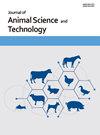饲粮中褪黑素通过调节早期断奶大鼠和猪的蛋白质生物利用度和行为对生长性能的影响
IF 2.7
3区 农林科学
Q1 AGRICULTURE, DAIRY & ANIMAL SCIENCE
引用次数: 0
摘要
褪黑素由色氨酸产生,具有多种生物功能,包括调节昼夜节律、镇静和抗氧化能力。因此,我们在早期断奶的大鼠和猪身上进行了两项实验来研究褪黑素的抗氧化和镇静作用。大鼠实验选用42只21日龄大鼠,测定其抗氧化能力。接下来,我们用120头早期断奶仔猪(21日龄)进行了为期5周的实验,以评估褪黑素对能量消耗运动(包括漫游和战斗状态)的减少作用。与对照组相比,膳食中补充褪黑素显著改善了大鼠和猪的生长。此外,与饲喂基础饲料的大鼠相比,饲喂褪黑素补充饲料的大鼠表现出更高的抗氧化能力,肝脏丙二醛浓度降低。此外,与对照组相比,饮食中摄入褪黑素增加了8-21天的休息和摄食行为,减少了漫游和打架行为。总的来说,在猪的社会等级建立之后,早期断奶动物在饲料中添加褪黑素后,通过上调肝脏抗氧化能力和减少能量浪费行为(包括漫游和战斗状态),显示出生长的改善。本文章由计算机程序翻译,如有差异,请以英文原文为准。
Dietary effects of melatonin on growth performance by modulation of protein bioavailability and behavior in early weaned rats and pigs
Melatonin, which is produced from tryptophan, exerts various biological functions, including the regulation of circadian rhythm, sedative agents, and antioxidant ability. Therefore, we conducted two experiments with early-weaned rats and pigs to investigate the antioxidant and sedative effects of melatonin. In the rat experiment, a total of 42 rats (21 days old) were used, and the antioxidant capacity was determined. Next, we used 120 early-weaned piglets (21 days old) to conduct a 5-week experiment to evaluate the reductive effect of melatonin on energy-wasting movement, including roaming and fight states. Dietary melatonin supple - mentation significantly improved growth in both rats and pigs compared to the control groups. Additionally, rats fed a melatonin-supplemented diet showed advanced antioxidant capacity with a decrease in hepatic malondialdehyde concentration compared to rats fed a basal diet. Moreover, dietary melatonin ingestion increased resting and feeding behaviors and reduced roaming and fight behaviors during Days 8–21 compared to the control diet group. Collectively, early weaned animals given dietary melatonin supplementation showed improved growth through upregulation of hepatic antioxidant capacity and minimization of energy-wasting behavior, including roaming and fight states, after pigs’ social hierarchy establishment.
求助全文
通过发布文献求助,成功后即可免费获取论文全文。
去求助
来源期刊

Journal of Animal Science and Technology
Agricultural and Biological Sciences-Food Science
CiteScore
4.50
自引率
8.70%
发文量
96
审稿时长
7 weeks
期刊介绍:
Journal of Animal Science and Technology (J. Anim. Sci. Technol. or JAST) is a peer-reviewed, open access journal publishing original research, review articles and notes in all fields of animal science.
Topics covered by the journal include: genetics and breeding, physiology, nutrition of monogastric animals, nutrition of ruminants, animal products (milk, meat, eggs and their by-products) and their processing, grasslands and roughages, livestock environment, animal biotechnology, animal behavior and welfare.
Articles generally report research involving beef cattle, dairy cattle, pigs, companion animals, goats, horses, and sheep. However, studies involving other farm animals, aquatic and wildlife species, and laboratory animal species that address fundamental questions related to livestock and companion animal biology will also be considered for publication.
The Journal of Animal Science and Technology (J. Anim. Technol. or JAST) has been the official journal of The Korean Society of Animal Science and Technology (KSAST) since 2000, formerly known as The Korean Journal of Animal Sciences (launched in 1956).
 求助内容:
求助内容: 应助结果提醒方式:
应助结果提醒方式:


